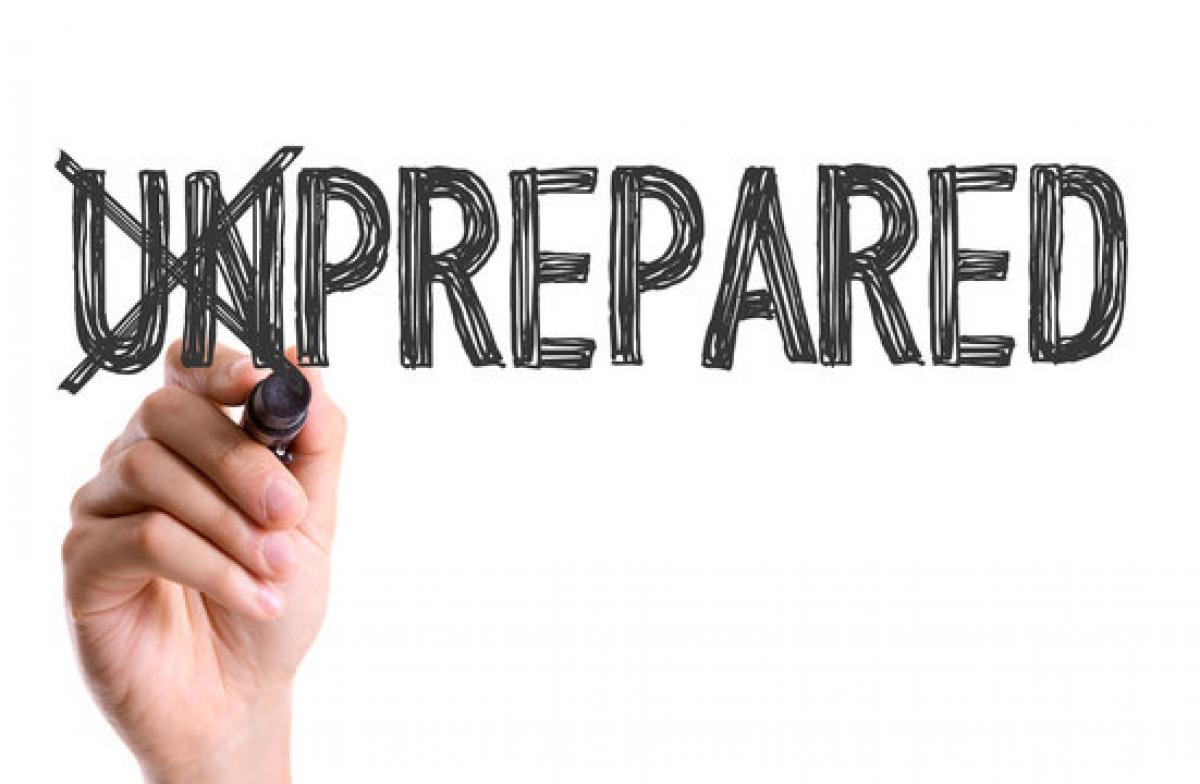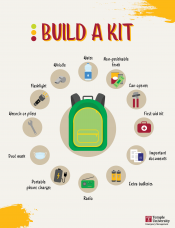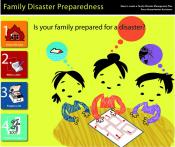Make an Emergency Plan

What is emergency preparedness?
The term refers to the steps you take to make sure you are safe before, during and after an emergency or natural disaster. These plans are important for your safety in both natural disasters and man-made disasters. Examples of natural disasters are floods, blizzards, tornadoes and earthquakes. Man-made disasters can include explosions, fires, chemical and biological attacks.
People with disabilities may be especially vulnerable during and after emergencies. In an emergency, many systems you rely on may not function as well as they usually do. Familiar landmarks and usual travel routes you and your service animal know may be altered. Utilities like electricity, water, gas and phone service may be disrupted. You might need to temporarily evacuate to a shelter which may not be fully accessible for your needs.
Be Prepared
We are glad that you have chosen to take an active role in protecting and preparing yourself and your family for an emergency. This section will guide you through the necessary steps to be prepared for any emergency, natural or otherwise, following 3 simple steps: Get a Kit, Make a Plan, Be Informed.
Our mission is to partner with local jurisdictions, the private sector, and non-profit organizations to coordinate and promote a comprehensive, risk-based program of local emergency management in order to establish a disaster resilient community in Polk County. These various entities assist citizens and their communities to prepare for, respond to, recover from, and reduce the effects of natural, civil, and technological emergencies and disasters. The primary goal of emergency management is to prevent injuries, save lives, and reduce property damage in your community.
Polk County Emergency Management is continually updating the emergency plans we have to face new threats, but we can’t do it alone. Working together, we can make Polk County as prepared as any county can be. When we work together, we can confront any emergency.
Additional Resources
- American Red Cross
- Federal Emergency Management Agency (FEMA)
- Oregon Emergency Management
- Polk County Environmental Health Disaster Preparedness
- Ready America

Make a Plan
#PrepareToProtect means preparing to protect everyone you love. Start by making a plan before disasters and emergencies strike. www.ready.gov/plan
Discuss with your household or family how you will communicate if there is an emergency.
Decide and practice your emergency plan with members of your household.
Houses, mobile homes, apartments, and high-rise buildings have different evacuation considerations. Make a plan for each: www.ready.gov/plan-for-locations
Involve your entire family, including your children, in planning for disasters and emergencies so they are prepared, not afraid www.ready.gov/plan

Build a Kit/Go bag
If you need to leave from your home, it will be important that you are ready to go as quickly as possible. Some people find that having a Go Bag in an accessible place ensures that you and your family are prepared for whatever situation arises. Should you decide to prepare a Go Bag, here are some things to consider.
Go Bag Guidelines
- Each member of your household should have his or her own Go Bag
- Go Bags should be easy to carry and sturdy
- Go Bags should be stored in an easily accessible location
- Ideally, you should keep a Go Bag at your home, in your car, and at work
- Go Bags should be prepared for any time of year
- Go Bags should be updated every six months
Go Bag Item List
- Bottled water
- Non-perishable food and a manual can opener
- Flashlight
- Battery-operated AM/FM Radio
- Extra batteries (check the necessary types)
- Pocketknife
- Whistle
- Prescription medication for a week, along with copies of your prescriptions
- Small first aid kit
- Extra house and car keys
- A blanket
- Rain gear
- A hat
- Comfortable, sturdy shoes
- Warm clothes
- Extra pair of glasses and/or hearing aids
- Toilet paper
- Plastic garbage bags
- Soap
- Toothbrush and toothpaste
- Feminine hygiene products
- A copy of your communications plan card
- A regional map
- Special needs items for members of your family, especially children, seniors, people with disabilities, and pets.
- Paper, pens, and tape – in case you need to leave a message somewhere
- Cash – preferably in small denominations
- Cell Phone and Charger
- Copies of important documents in a waterproof container (i.e. IDs, insurance information, proof of address, passports, etc.)
- A recent family photo for identification purposes - make sure everyone’s face can be seen clearly

Low-Cost, No-Cost Preparedness
Download or order your free preparedness products to help your family plan and prepare for the next emergency. www.ready.gov/publications
Drills aren’t just for your toolbox. Practice emergency drills with your family regularly.
Emergencies can happen anytime, and less than half of American families have a communication plan. Plan ahead: www.ready.gov/kids/make-a-plan
Make preparing fun for kids! Go on a scavenger hunt around your house for items you already have to add to your disaster supply kit. Follow this list: www.ready.gov/kit and see how many items you can check off!
Know what disasters and hazards could affect your area, how to get emergency alerts, and where you would go if you and your family need to evacuate. Visit: www.ready.gov/be-informed.

Teach Youth About Preparedness
Review your family emergency communications plan with kids at your next household meeting.
Kids, parents, & educators, visit the Ready Kids web pages in Spanish: www.ready.gov/es/ninos
Need tips for talking to your kids about natural disasters? Visit www.ready.gov/kids/parents
Many Americans aren’t familiar with their child’s school evacuation & reunification plans. Are you?
Kids can become Disaster Masters with this @Readygov preparedness game: www.ready.gov/kids/games
Get involved in Teen CERT. Find opportunities by learning about Teen CERT online: www.ready.gov/kids/teen-cert
Your community needs YOU! Find opportunities to help your community here: www.ready.gov/youth-preparedness

